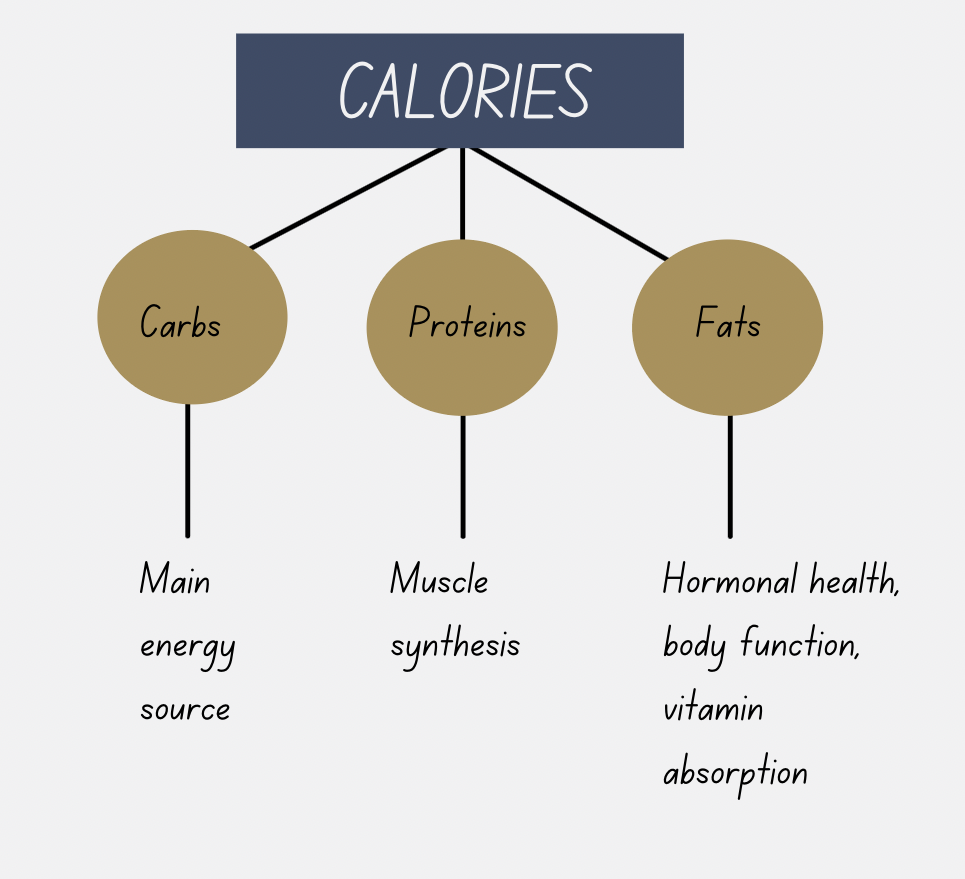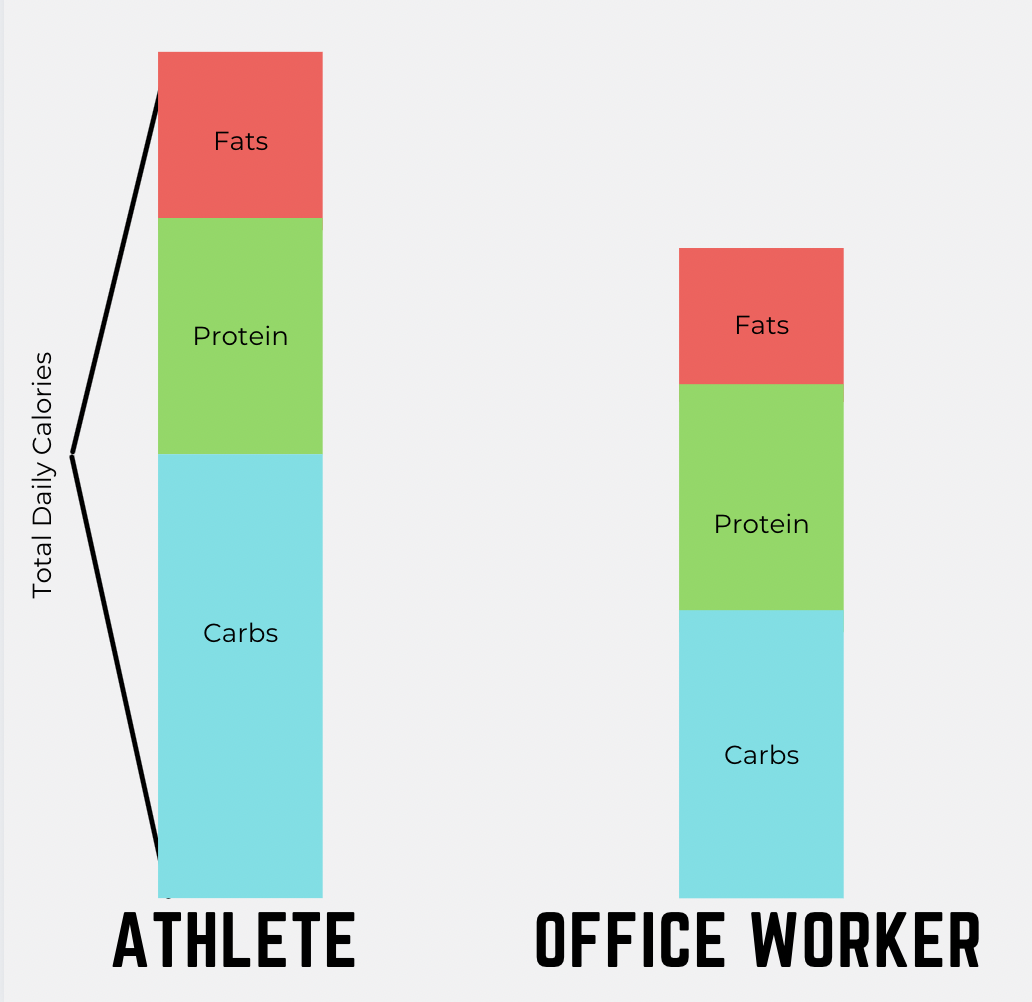Blog Content:
-
Introduction
-
Caloric Expenditure
-
What are Macros?
-
Macro Math
-
Should I track?
-
Take-away Messages
Introduction
One of the most well-known diet methods is “if it fits your macros”, also known as IIFYM. This diet requires one to track their macronutrient intake, also known as macros. This diet method is not for everyone and requires one to be familiar with the breakdown of calories and macronutrients for fueling the body properly. You may be thinking: what are macros? Why does it matter when it comes to muscle building and/or fat loss? Let’s see what it is all about!
Caloric Expenditure
Let’s start by looking at calories. Calories are a unit of energy. When we eat, we are taking in calories, which gives us energy to perform in our daily lives and cumulative activities, to include exercise. Food is fuel.
While we consume calories throughout the day, we expend it as well. This is done through several methods. Caloric expenditure includes basal metabolic rate (BMR), exercise/activity, thermal effect of food, and non-exercise activity thermogenesis (NEAT). BMR is the energy your body needs to perform it’s necessary life-functions, such as organ function and breathing. This is the energy needed for you just to be alive. It is the amount of calories you burn if you were to just lay down and do nothing all day. Another way calories are burned- besides the obvious exercise/activity- is through NEAT, which is the cumulative calories burned through small movements throughout the day. This includes things such as twitching, tapping your foot, typing/writing, i.e, movement that is not intentionally done through exercise. If your job requires you to be on your feet a lot, like nurses, then your NEAT will be higher than someone who works in an office for a living. Although NEAT includes small things like tapping your foot or moving your hands, the calories through these small movements add up in the long run.
When you consume more calories than what you expend, the calories not used are stored in the body and results in weight gain. When you expend more calories than what you consume, then weight loss is the result. This can be summarized using the energy balance:
What are macros?
Macronutrients, most commonly known as macros, are the building blocks of calories. Calories are made up of carbohydrates, fats, and protein. Each macronutrient has its own function, which we will get into more detail in future blogs. For now, the goal is to introduce these macronutrients, which are the building blocks of the fuel we consume for daily life and activities. In the figure below, you’ll see a quick recap of each macro function:
As shown in the figure, each macronutrient has a different role in the body which is why we want to make sure to eat enough of each. We do not want to eat JUST carbs, or JUST protein, because our bodies need each macronutrient. Ideally, you want enough of each that will allow for proper muscle synthesis and recovery, energy fuel for performance, and overall health.
Each person requires a different amount of calories per day, and different macronutrient breakdowns of those calories. If one person were a high-level endurance athlete, they would require a lot of calories and their carbohydrate intake levels would be relatively high because they need that energy source for their sport. That being said, they would still be taking in protein and fats too. It is essential that everyone consumes each macronutrient. Someone who is less active and not an athlete may need to intake less calories and less carbs, but have a more even breakdown of their macronutrients.
Macro Math
Foods can have the same caloric density but different macronutrient breakdown. For example, a banana is typically 100 calories of carbs; a protein shake is also 100 calories, but it’s all protein; and a tablespoon of peanut butter is 100 calories but it is mostly fats.
Each macronutrient is different, has different functions in the body, and have different caloric densities:
-
4 calories per 1 gram of Carb
-
4 calories per 1 gram of Protein
-
9 calories per 1 gram of Fat
The equation to calculate the total calories in a food, using the macronutrient breakdown, is:
Total calories = 4*(grams of Carbs)+ 4*(grams of Protein)+9*(grams of Fat)
This equation can be used when reading a nutrition label:
Should I track?
In my opinion, tracking your macros is tedious work. It requires one to know their TDEE (total daily energy expenditure) – which takes a while to find out through trial and error- and determining what macronutrient breakdown is best for them, depending on their goals (weight loss, weight gain, muscle building, performance based) and specific metabolic needs. Some people are able to lose weight on high amounts of calories because of having a fast metabolism and high TDEE, while others will need to have lower calories for weight loss because their individual caloric needs are different. In the figure below, there is an example for a weightlifting athlete, who is aiming to maintain weight and fuel for performance. These numbers would be different for someone else, because everyone’s needs are different.
Once you find out what your caloric needs are, that’s when you start tracking. The goal is to get your target macro numbers everyday by tracking what you eat. It gets easier with time, but still requires a bit of attention to detail and planning. There are apps to track your food intake, the most famous one is “MyFitnessPal”. This app allows you to scan the barcode of most foods; once you scan it, the food will pop up with the macronutrient breakdown and you add it to your log book. It will record the macros for you and show you how much more macros you have left for the day. The reason I do not like to preach this method of dieting/lifestyle is because it consumes people mentally. It places too much focus on your food, can create obsessive behaviors, and can create unnecessary stress. The first blog I wrote about nutrition was the Plate Method, and I believe that’s a more sustainable approach. You don’t need to be overly obsessive about your macros and food intake, as long as you feel good, get enough protein (about 1 gram per pound of bodyweight), and eat whole foods packed with micronutrients, then you should be good to go! IIFYM and macro-counting is a great tool to get a baseline of your metabolic needs, but it can take a toll on someone mentally.
Being aware of your macros is great. It’s a powerful tool and you get to familiarize yourself with your body’s needs. Also, being aware of different macronutrient breakdowns in foods through understanding their nutrition labels is great knowledge to have too. However, I would recommend tracking macros for advanced athletes who need to be extremely specific with their diet in order to reach peak performance for a competition, for those who have been dieting or eating healthy for a long period of time and need more specific guidance, or for someone who is on a timeline for weight loss (such as having an upcoming wedding to prepare for). Other than that, I recommend just being smart with your food choices, focusing on making small sustainable changes, and tracking protein only.
Take-Away Messages
-
IIFYM/Macro Counting can be tedious and it’s a lot of information. This blog can be hundreds of pages long if I just blabbed on about macros and the science behind nutrition. There’s a lot of information that comes with this, which can be overwhelming. We will be writing blogs on protein, carbs, and fats separately to keep building on this foundation.
-
Sustainable Changes. If you haven’t dieted properly before, or haven’t focused much on your nutrition, don’t jump into macro counting just yet. Instead, make small sustainable changes. If you go out to McDonald’s 4x a week, start making small changes by going only 2-3x a week. Then after a while, go 1x a week. Trust me, this will make healthy eating habits a lot easier for you!
-
Keep it Simple. This can be very overwhelming, but make sure to not stress about it and keep it simple (easier said than done). It’s very easy to overcomplicate your nutrition, but we recommend starting with the plate method as well as doing those small sustainable changes mentioned above.
-
Track your Protein! Although I don’t recommend jumping into macro-counting right away (unless you have experience or are a performance athlete), I do recommend being more cognizant of your protein intake. Try to get in 0.8 to 1 gram per pound of your bodyweight. For example, if you weigh 150 lbs, then shoot for 120 to 150 grams of Protein per day.







